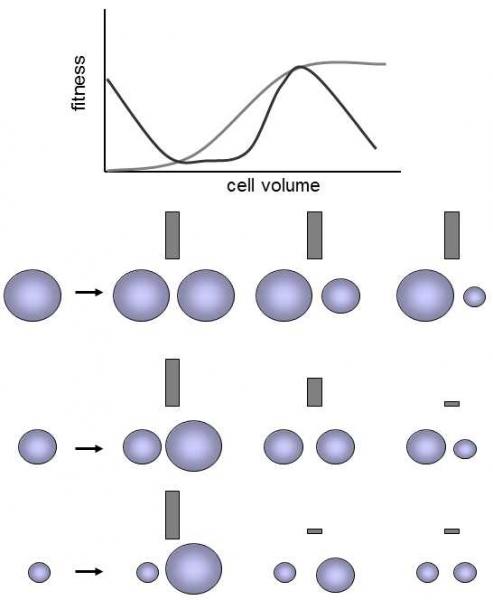XIV.2.1 Morphological anisogamy may be the outcome of the simultaneous effect of two antagonistic selection pressures
At least two contradictory requirements are placed on the morphology of gametes.On the one hand, the sex cell must contain a sufficient amount of cytoplasm and energy stores to ensure full functionality of the future zygotes; on the other hand, it should be as small as possible, either because a small cell is more mobile or because more small cells can be formed while expending the same amount of resources (Fig. XIV.1.).

Fig. XIV.1 Morphological anisogamy as a consequence of the effect of disruptive selection. The grey curve on the graph and the height of the grey columns in the figure designate the dependence of the fitness of the zygote on its size. The relationship is nonlinear; below a certain size, the viability of the zygote is almost zero, above a certain size, it no longer increases. The black curve on the graph depicts the dependence between the fitness of an individual and the size of the gametes that it produces. The shape of the curve is a result both of the character of the dependence between the size of the zygote and its viability and also the necessary existence of a negative correlation between the size of a gamete and its cost, i.e. the number of gametes that an individual produces for a particular expenditure of resources. The disadvantage for individuals producing gametes of medium size is a result of the fact that zygotes formed by the combination of medium-sized gametes with small gametes are basically unviable, while zygotes formed by combination of medium-sized gametes with large gametes are not much more viable than gametes formed by combination of small (and cheap) gametes with large gametes.
It is obvious that it is difficult to satisfy both these requirements simultaneously.As a consequence, a certain type of disruptive natural selection acts on gametes, leading sooner or later to differentiation of the cells into small “cheap” and mobile microgametes and large macrogametes (Parker, Baker, & Smith 1972).
